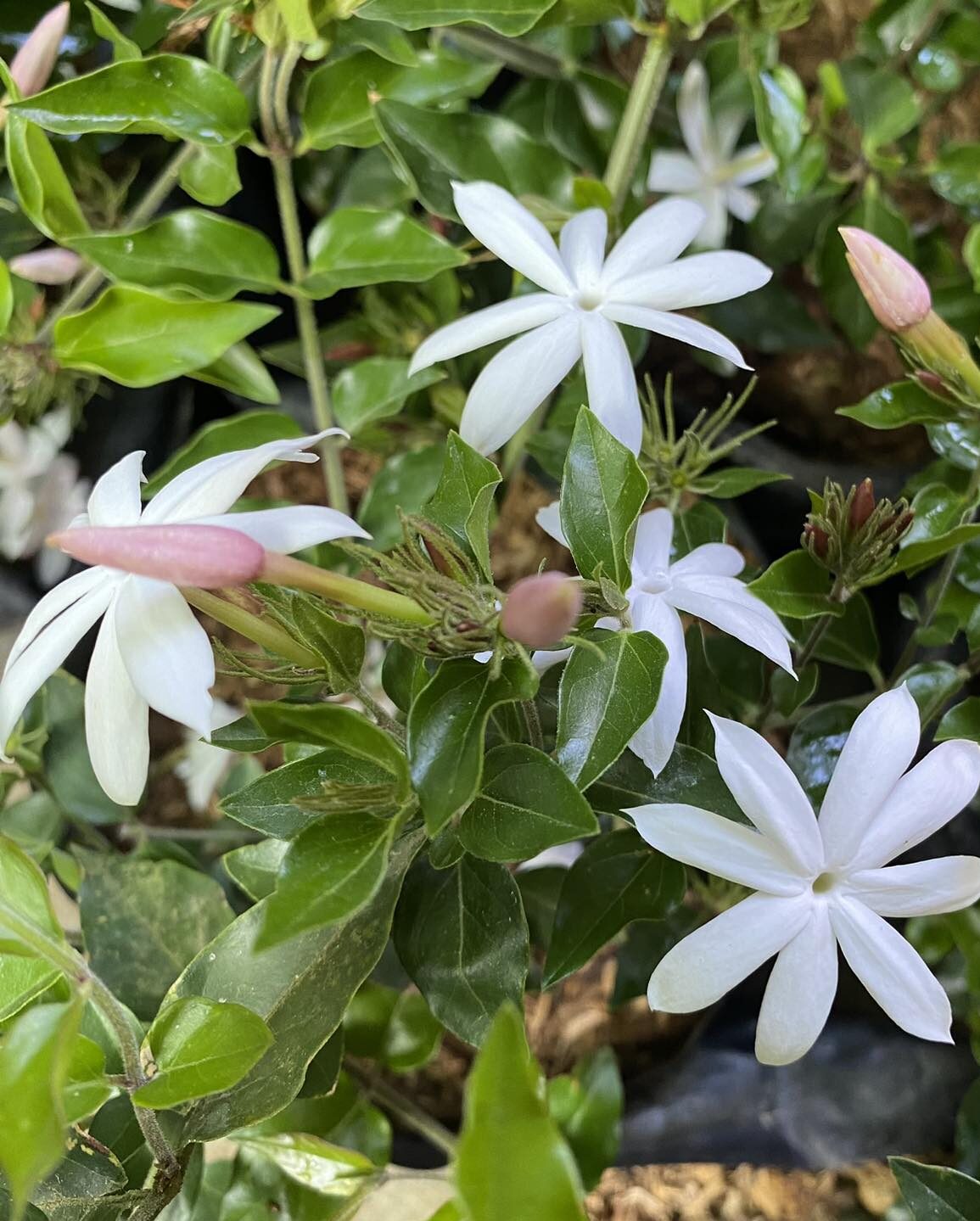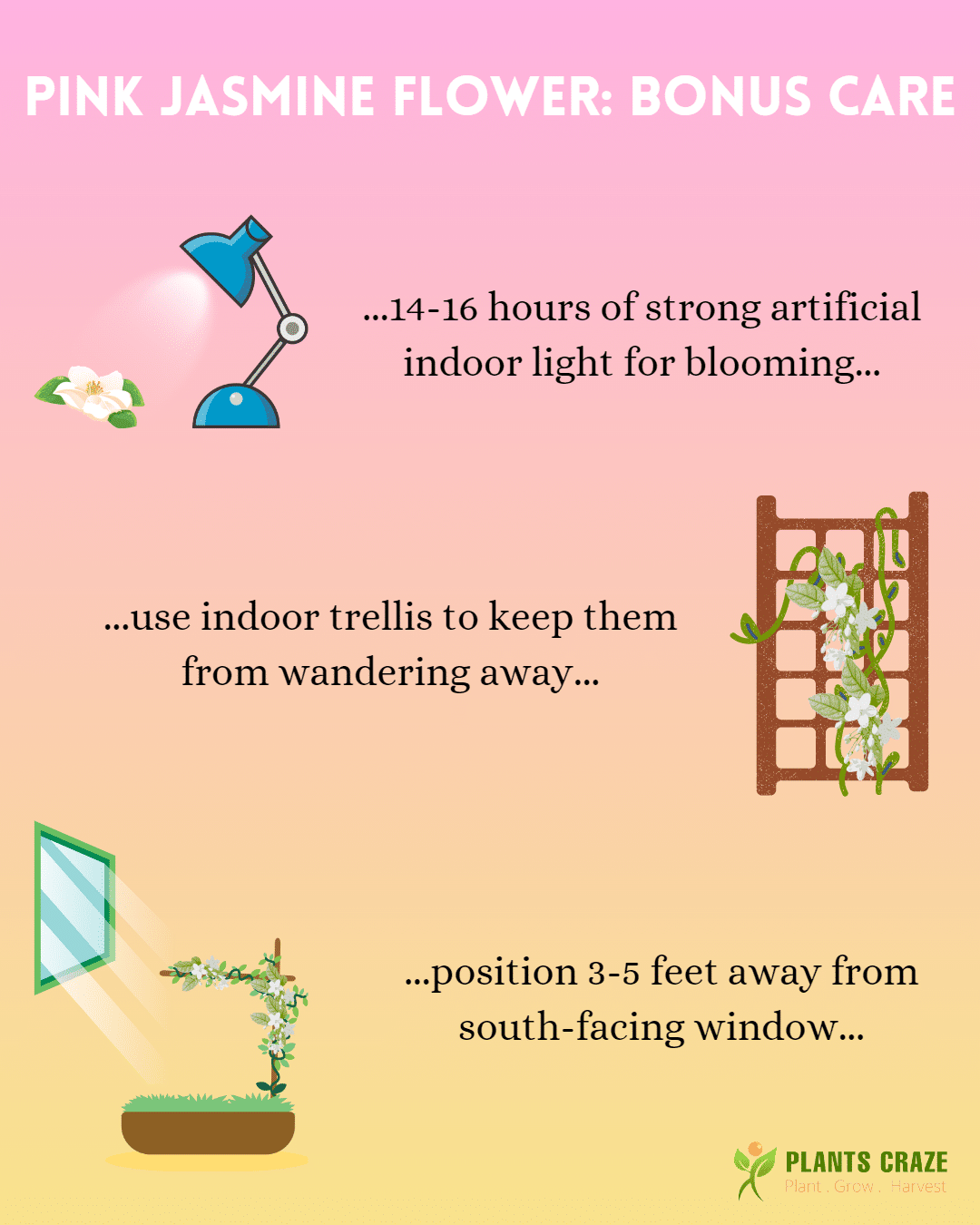Jasmine is derived from the Persian name ‘Yasmin,’ meaning ‘Gift from God,’ and the aromatic Pink Jasmine Flower justifies this reasonably.
The plant starts working on new blooms in the fall when they need utmost care. So help them brace for a new blooming stretch!
Table of Contents Show
How Often Does the Pink Jasmine Flower?
Native to China and Myanmar, Pink Jasmine, an evergreen climber, blossoms with white star-like flowers, hardy within zones 7-10.

The plant takes at least 3-4 years to mature and adorn its first blooms.
Likewise, the plant responsibly sets fresh flower buds again during fall for the following annual flowering flush.
So, you can trigger the blossoms by applying phosphoric fertilizer every 1-2 weeks from early spring until summer.
However, late winter to early spring is also the perfect time to feed your plant as it wakes from dormancy.
Pink Jasmine Flower Overview
Pink Jasmine is an evergreen undercover climber that can grow up to 20-25 feet tall.
So, the bigger the plant, the more sweet-scented blooms cover its flowering vines and stems, lavishing it with a fragrant vibe.
Let’s learn about the Pink Jasmine Flowers in detail from the table below.
| Feature(s) | Description(s) |
|---|---|
| Structure | Inflorescence: Cymose Shape: 5-Petaled, Long-Tubed and Starry Color: Creamy White to White or Pinkish-White Size: About 1 Inch in diameter Fragrance: Intensely Sweet and Floral |
| Family | Oleaceae |
| Growing Seasons | Early Spring to Late Fall |
| Flowering Periods | Late Winter to Spring or Early Summer |
| Flower Lifespan | 24 Hours to 2 Weeks |
| Fruit | Structure: Blackish-Blue Berry With One Seed Season: Early to Mid-Spring Until Early Summer |
| Toxicity | Non-Toxic to Humans and Pets |
Pink Jasmine Flower Pollination
Although Pink Jasmine Flowers are bisexual (with male and female parts), self-pollination is impossible as they take different times to mature.
Butterflies and bees provide a helping hand by transferring the pollens from one flower to the next.
After pollination, the flowers wither to brown and fall off the plant.
Meanwhile, dark blue and single-seeded fruits replace the flowers in early to mid-spring until early summer.
How to Make a Pink Jasmine Plant Flower?
Pink Jasmine does not ask for extra special treatment to bloom. Here are some quick fixes to the problem of Pink Jasmine not blooming.
- Offer at least 4-8 hours of direct sun in the morning or evening and shade in the afternoon. Locate the plant in an area that receives southern sun exposure.
- Provide daytime temperatures between 60°F and 75°F. Expose the plant to 4-5 weeks of nighttime temperatures around 33-59°F before the flowering spell in late winter.
- Prune the plant in late spring to remove the spent blooms, and groom the plant again in late summer to remove the scraggy growth to provide space for new flowers.
- Use a liquid bloom-fostering feed of one-quarter strength every 1-2 weeks throughout early spring and summer but prevent fertilizer application in fall and winter.

- Water every 2 weeks from spring until the fall, inspect the soil for dryness before watering in winter, and sustain a humidity of around 40-50%.
- Provide loose, porous soil with a pH between 5.5 and 7.1. Keep the soil draining, organic, and moist by adding organic perlite, compost, and peat moss.
- Use neem oils to combat pests like budworms, gallery worms, jasmine mites, bugs, and fungal diseases like sooty mold fungus that mainly attack the flower heads and buds.
- Ensure to keep your Pink Jasmine slightly rootbound to bloom. Repot once a year in the early weeks of the growing season.
What to do with Pink Jasmine After Flowering?
Pink Jasmine plants are quick growers and become invasive by growing uncontrollably, making no room for other plants.
If their size or space for new growth is not managed, Pink Jasmine plants will waste unnecessary energy on aging parts and cannot focus on new growth and blooms.

Besides, one of the suitable measures to pinpoint the pruning time is when the flowers fade to brown and start crisping!
However, pruning them before blooming will cut off the buds, stopping them from flowering.
How to Prune Pink Jasmine Plant?
Here is a stepwise guide to pruning the plant.
- Select the flowers on your plant that are shrinking and looking infected.
- With sterilized pruners, cut down the flowering and vegetative stems to the ground at 45° if the branches are unhealthy.
- Collect and burn the spent blooms from around the plant’s base to cut off the source of infection or compost them in the soil.
- Clear up from the sides to keep the plant contained and thin out the crossed or tangled vines.
- Shorten healthy vines to about 3 feet to prevent the plant from becoming top-heavy.
If you want to learn more about the pruning steps, go through this video!
Uses of Pink Jasmine Flowers
Flowers of Pink Jasmine are meaningful, culturally symbolic, and medicinally vital in food, health, and cosmetics.
1. Symbolic Meanings & Uses
- Pink Jasmine Flowers symbolize affection, beauty, modesty, purity, kindness, and new love.
- In Thailand, the flowers signify motherhood, love, and respect, whereas, in the Philippines, they are used in weddings and religious ceremonies.
- Moreover, in the Southern States of India, Flowers of Pink Jasmine are used by women as a garland around their hair.
2. Medicine and Health
- A 2019 research mentions that flower extracts have anti-microbial, anti-bacterial, anti-cancer, anti-diabetic, and anti-inflammatory properties.
- Furthermore, antioxidants in Pink Jasmine Flowers help improve digestion, ease stomach pain, and enhance heart health.
- Also, flowers are crucial ingredients of traditional remedies in China and India for hepatitis, stomatitis, and duodenitis.
- In cosmetic industries, the scented flowers serve their uses in perfumes, skin toners, conditioners, and shampoos.
- Moreover, Jasmine oil is a great relaxant and stress reliever and has a soothing effect on nerve activity and mood.

3. Food and Beverage
Pink Jasmine Flowers are edible, served in salads and desserts, or used as garnishes.
Additionally, they are used to make other herbal teas, jasmine rice, and sorbets.
If you are a fan of herbal tea, use the Pink Jasmine Flower to add its floral scent and flavor to your tea!
Pink Jasmine Flower Tea Recipe
Here’s a simple tea recipe that you might like.
- Take out some of the fresh Pink Jasmine blooms.
- Prepare yourself with black or green tea in a kettle.
- Add flowers to a tea kettle and shake it after closing the lid.
- Let it rest for 24 hours to infuse scents.
- Take out the Jasmine from a kettle and enjoy the scented tea.
- Repeat the process 2-3 times to get a more potent scent by replacing flowers every 24 hours.
Additionally, you can dry some flower buds and flowers, keep them in tea bags and enjoy hot tea whenever you want.

Are Pink Jasmine Flowers Poisonous?
No wonder everyone doubts the perfectly beautiful, sweet-smelling, and easy-to-grow Pink Jasmine for hiding any dark side.
But still, ingestion might cause minor stomach upsets in pets and may also cause choking.
Additionally, a recently fertilized plant can turn fatal regardless of the plant’s nature.
Call Animal Poison Control Center at (888) 426-4435 for medical assistance if you suspect abnormal symptoms.
FAQs About Pink Jasmine Flower
Is the Pink Jasmine Flower and Star Jasmine Flower the same?
Pink Jasmine belongs to the Oleaceae family, while Star Jasmine is an entirely different plant in the Apocynaceae family.
The flower petals of Star Jasmine are swirled, like a pin-wheel with side-dented ends, while Pink Jasmine flower petals have blunt ends.
Moreover, Star Jasmine has green flower buds, while Pink Jasmine flower buds are pink.
Is Pink Jasmine a true Jasmine?
Pink Jasmine (Jasminum polyanthum) is a true Jasmine that belongs to the family Oleaceae, attracting mostly birds, bees, and butterflies for pollination.
From Editorial Team
Pink Jasmine rewards with one of the perfect starry white flowers spreading an intensely sweet floral smell.
This pet-friendly flower will bless you with aesthetic beauty when provided with love and care.
